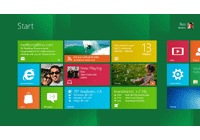
Microsoft unveils Windows 8 for public test
Seattle, February 29, 2012
Microsoft Corp unveils the first widely available test version of Windows 8 on Wednesday, giving the public the first chance to try out the slick, new-look operating system it hopes will restore the company's fading tech supremacy.
Windows 8, as the first Microsoft operating system compatible with low-power microprocessors designed by ARM Holdings, will run on tablets as well as desktops and laptops.
'The operating system has begun to be seen as largely irrelevant,' said Sid Parakh, an analyst at fund firm McAdams Wright Ragen, which holds Microsoft shares. 'This is the release that will have to prove its relevance all over again.'
Tablets and smartphones and cloud computing have made Bill Gates' vision of 'a computer on every desk and in every home' seem quaint, and Apple and Google and Amazon.com now set the agenda for the computing industry.
Still, all of those companies' fancy new hardware devices need basic operating software, and Microsoft is betting there is still more than a little room for Windows.
'The big increment here is that it'll be viable on the ARM platform, that there'll be a tablet form factor -- that kind of makes it a big deal,' said Dan Hanson, a portfolio manager at BlackRock, which holds 5 percent of Microsoft's shares through various funds.
'Microsoft correctly identified the relevance of the tablet form factor over a decade ago. This operating system may allow them to finally execute.'
Windows 8 will come in two main flavours -- one that works on the traditional x86 chips made by Intel Corp for desktops and laptops, and a new version for the ARM microprocessors that have become the standard for tablets, smartphones and other portable devices.
Microsoft says it is aiming to get machines running on both the ARM and Intel platforms into the market at the same time but has not set a target date.
In both versions, Windows 8 features a completely new interface, borrowed from what Microsoft calls the 'Metro' style of the current Windows Phone software. It features blocks or 'tiles' that can be moved around the screen or tapped to go straight into an application.
The tiles update in real time, so you can see if you have emails, voice messages or Facebook notifications at a glance. If PC and laptop users do not like the new format, they can revert to the old style with a click of the mouse.
The key for any operating software -- be it Apple's iOS for iPhones and iPads, Google's Android software for smartphones, or Windows -- is to attract the support of the software developers who build applications, and on that score Windows 8 is off to a decent start.
'The biggest hurdle our designers have had is trying to get inside the mood of a Metro user, where less is more,' said Paul Murphy, business development manager at Aviary, which makes a photo editing tool that can be integrated into iOS and Android apps. 'That was and still is a challenge, but I think now that they've been at it for a couple of months, they actually really like it. They appreciate the simplicity of the design.'
Developers who have already created apps for Microsoft's Windows Phone are finding it easier to adapt to Windows 8, said Ryan Lowdermilk, who hosts a popular podcast for apps builders.
'Porting your code over, people are finding that to be pretty straightforward. But as far as finishing that last mile where some of this newer technology for Windows 8 comes into play, they are finding little hiccups and bugs here and there.' - Reuters







